Jackson M.J. Micro and Nanomanufacturing
Подождите немного. Документ загружается.

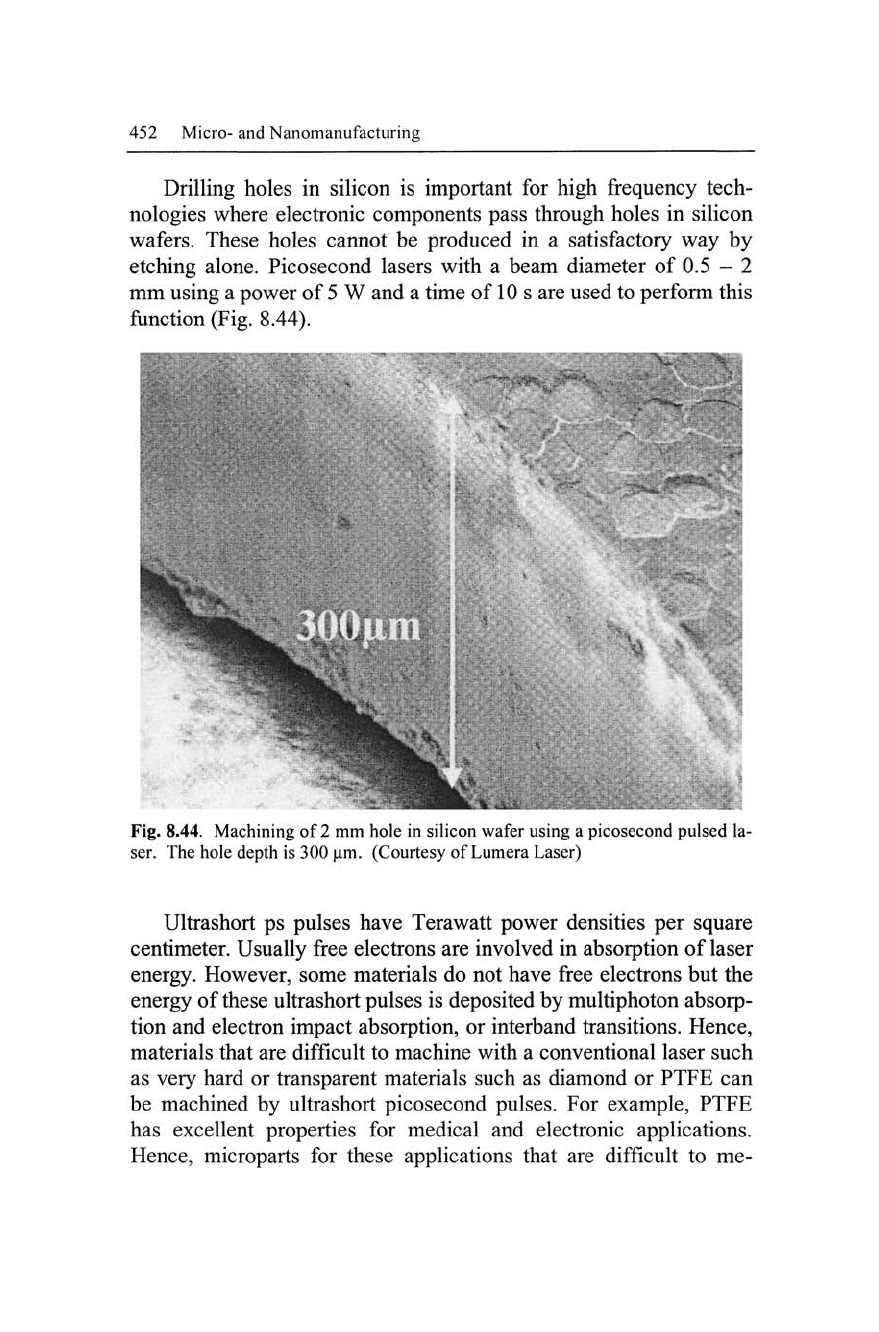
452 Micro- and Nanomanufacturing
Drilling holes in silicon is important for high frequency tech-
nologies where electronic components pass through holes in silicon
wafers. These holes cannot be produced in a satisfactory way by
etching alone. Picosecond lasers with a beam diameter of 0.5 - 2
mm using a power of
5
W and a time of 10 s are used to perform this
function (Fig. 8.44).
Fig. 8.44. Machining of 2 mm hole in silicon wafer using a picosecond pulsed la-
ser. The hole depth is 300 |Lim. (Courtesy of Lumera Laser)
Ultrashort ps pulses have Terawatt power densities per square
centimeter. Usually free electrons are involved in absorption of laser
energy. However, some materials do not have free electrons but the
energy of these ultrashort pulses is deposited by multiphoton absorp-
tion and electron impact absorption, or interband transitions. Hence,
materials that are difficult to machine with a conventional laser such
as very hard or transparent materials such as diamond or PTFE can
be machined by ultrashort picosecond pulses. For example, PTFE
has excellent properties for medical and electronic applications.
Hence, microparts for these applications that are difficult to me-
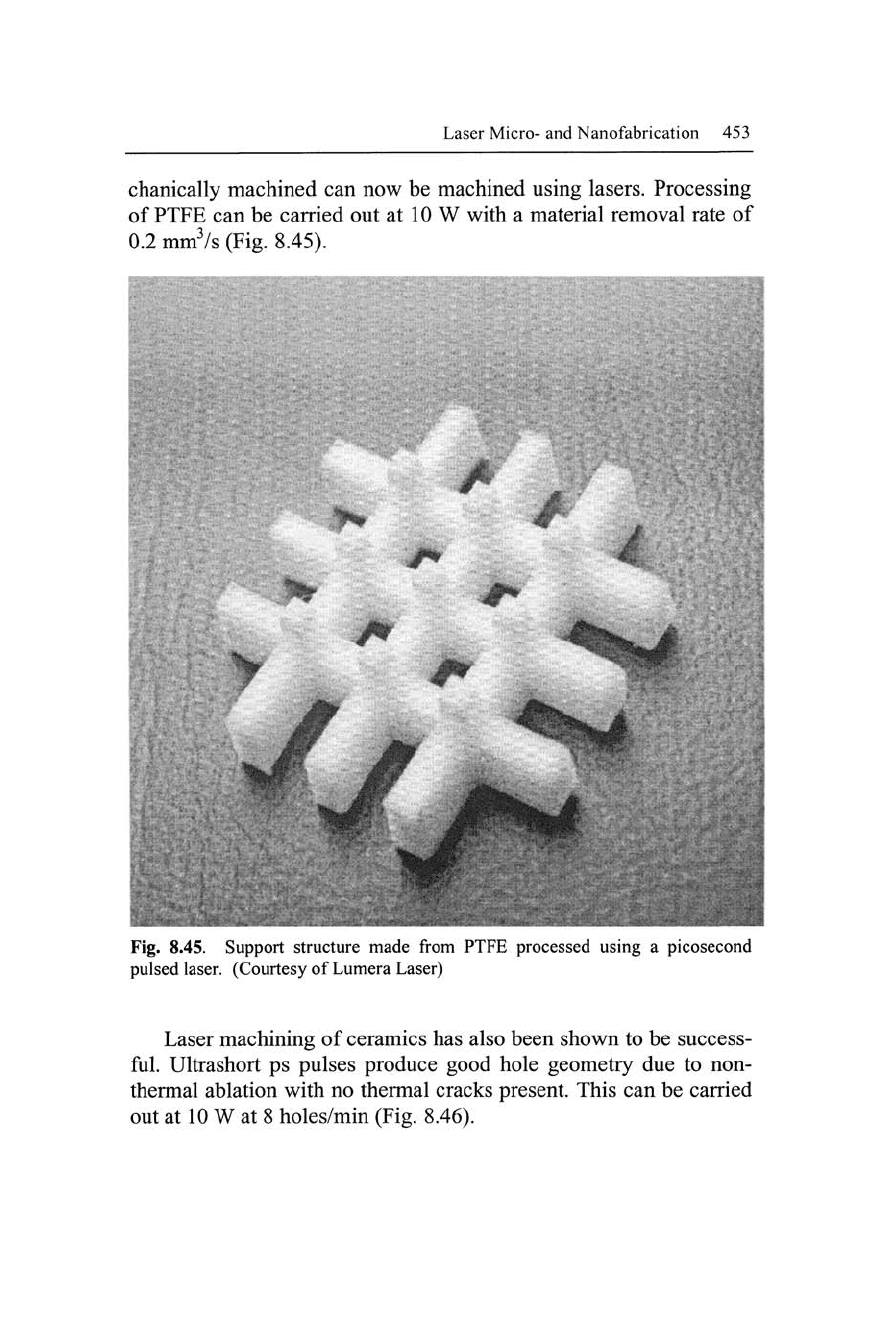
Laser Micro- and Nanofabrication 453
chanically machined can now be machined using lasers. Processing
of PTFE can be carried out at 10 W with a material removal rate of
0.2 mmVs (Fig. 8.45).
Fig. 8.45. Support structure made from PTFE processed using a picosecond
pulsed laser. (Courtesy of Lumera Laser)
Laser machining of ceramics has also been shown to be success-
ful.
Ultrashort ps pulses produce good hole geometry due to non-
thermal ablation with no thermal cracks present. This can be carried
out at 10 W at 8 holes/min (Fig. 8.46).
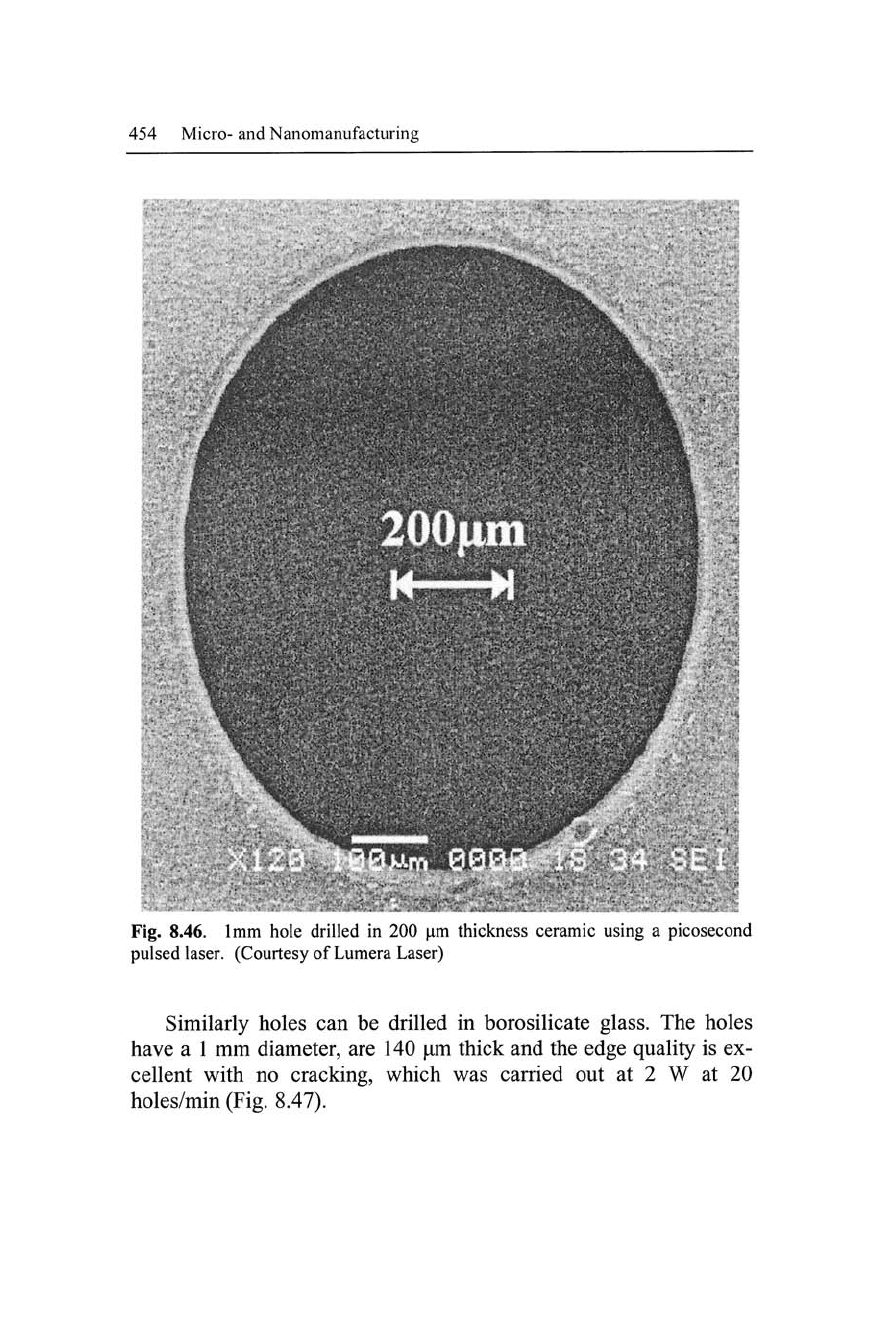
454 Micro- and Nanomanufacturing
Fig. 8.46. 1mm hole drilled in 200 )im thickness ceramic using a picosecond
pulsed laser. (Courtesy of Lumera Laser)
Similarly holes can be drilled in borosilicate glass. The holes
have a 1 mm diameter, are 140 jam thick and the edge quality is ex-
cellent with no cracking, which was carried out at 2 W at 20
holes/min (Fig. 8.47).
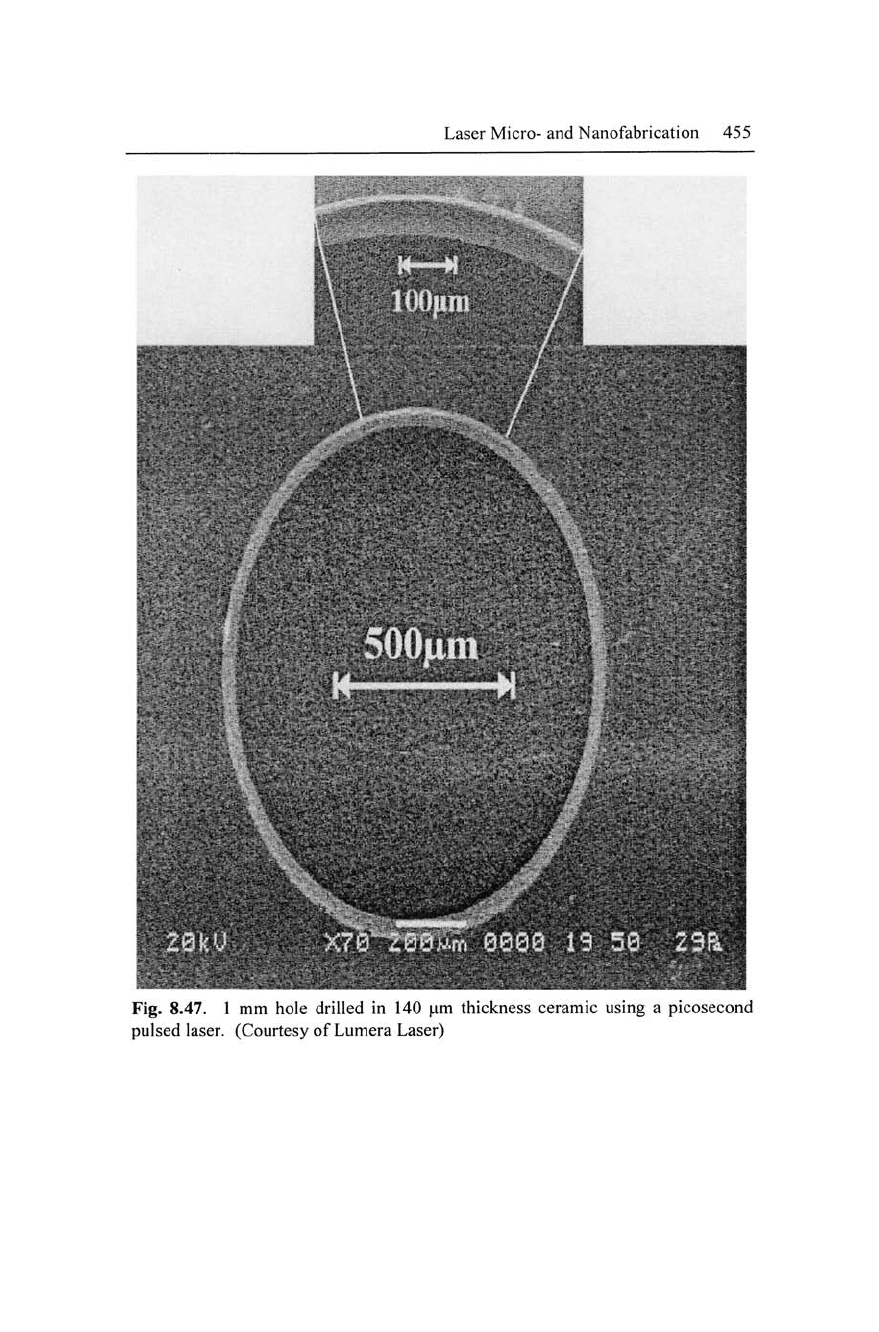
Laser Micro- and Nanofabrication 455
Fig. 8.47. 1 mm hole drilled in 140 |Lim thickness ceramic using a picosecond
pulsed laser. (Courtesy of Lumera Laser)
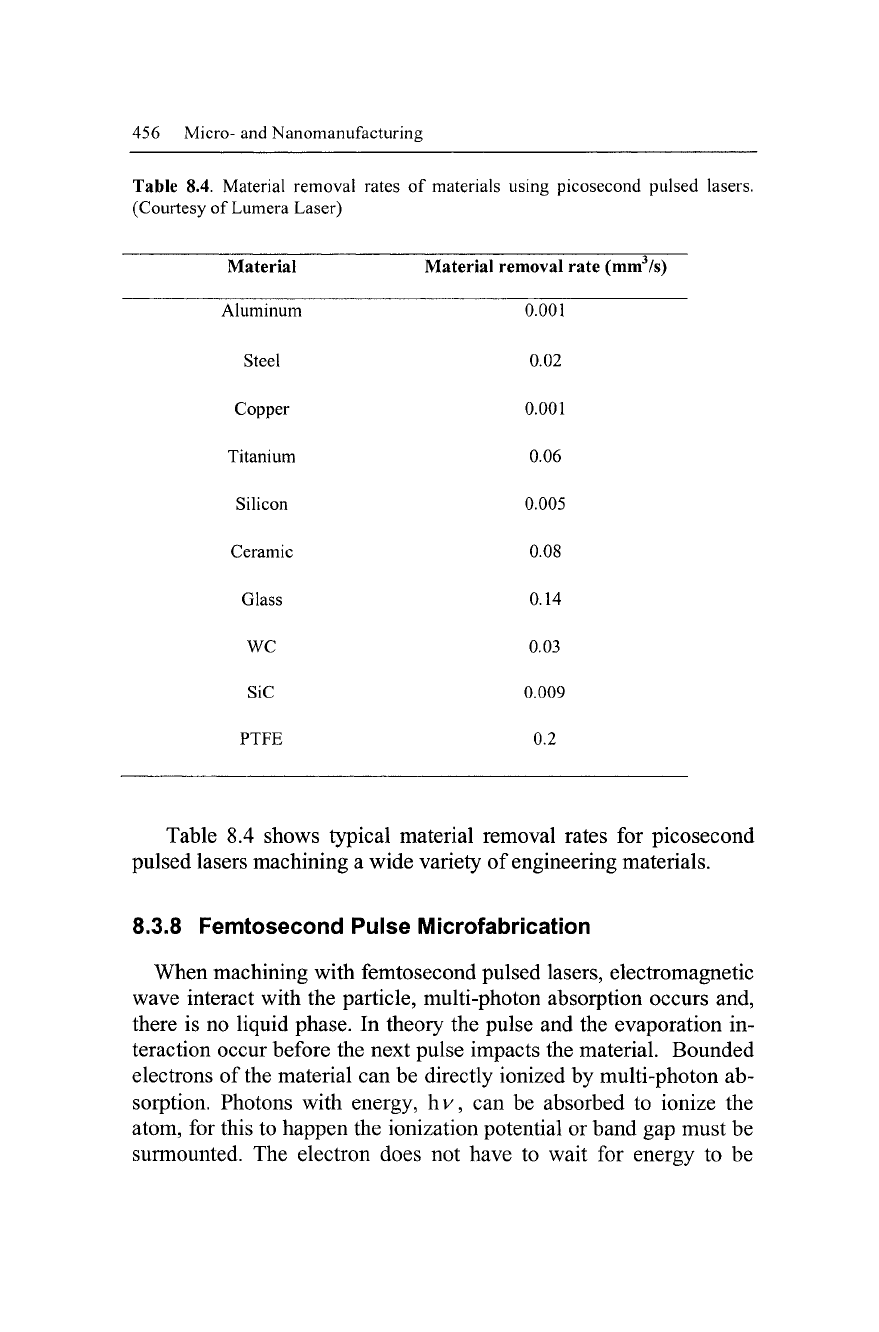
456 Micro- and Nanomanufacturing
Table 8.4. Material removal rates of materials using picosecond pulsed lasers.
(Courtesy of Lumera Laser)
Material Material removal rate (mm^/s)
Aluminum 0.001
Steel 0.02
Copper 0.001
Titanium 0.06
Silicon 0.005
Ceramic 0.08
Glass 0.14
WC 0.03
SiC 0.009
PTFE 0.2
Table 8.4 shows typical material removal rates for picosecond
pulsed lasers machining a wide variety of engineering materials.
8.3.8 Femtosecond Pulse Microfabrication
When machining with femtosecond pulsed lasers, electromagnetic
wave interact with the particle, multi-photon absorption occurs and,
there is no liquid phase. In theory the pulse and the evaporation in-
teraction occur before the next pulse impacts the material. Bounded
electrons of the material can be directly ionized by multi-photon ab-
sorption. Photons with energy, hv, can be absorbed to ionize the
atom, for this to happen the ionization potential or band gap must be
surmounted. The electron does not have to wait for energy to be
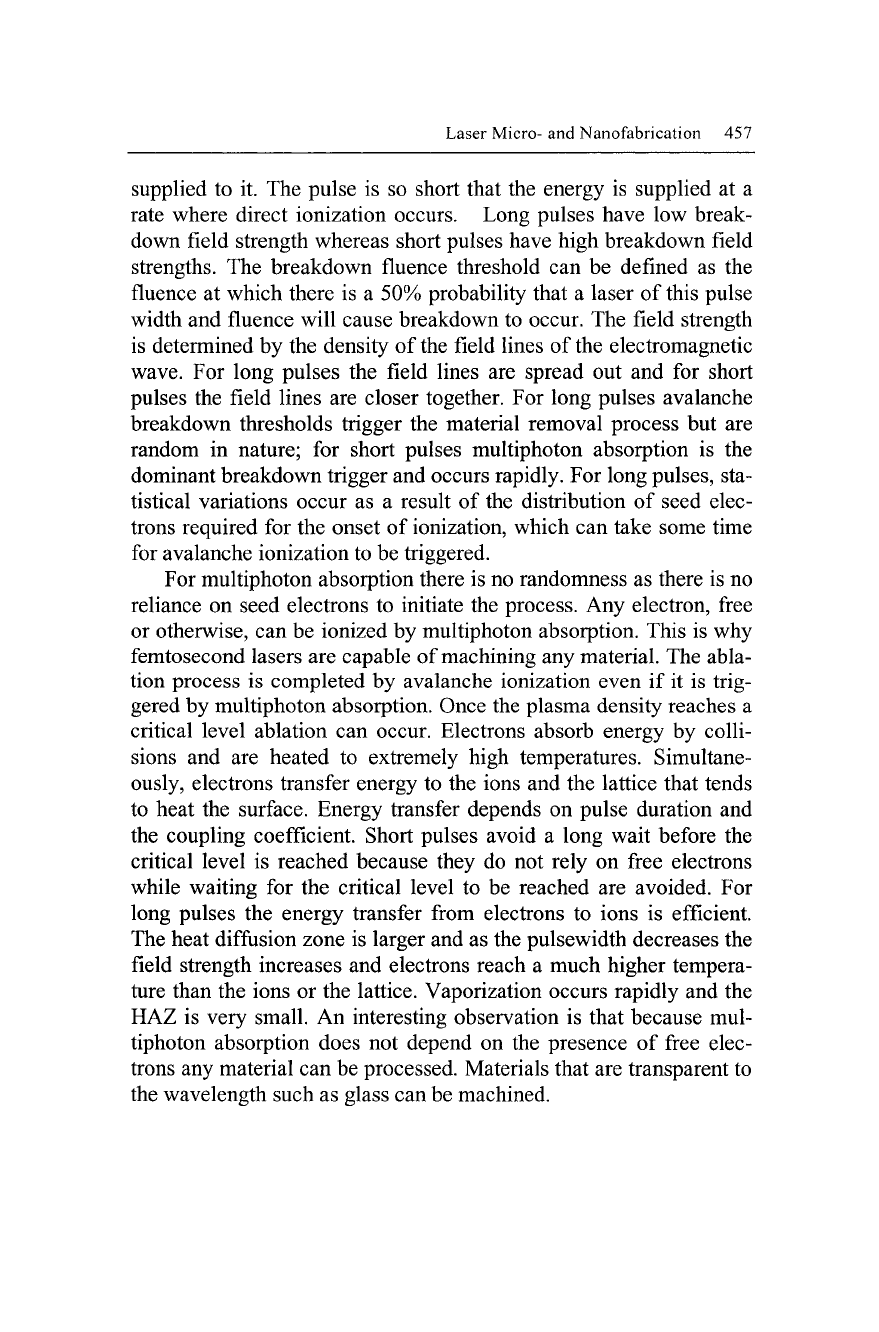
Laser Micro- and Nanofabrication 457
supplied to it. The pulse is so short that the energy is supplied at a
rate where direct ionization occurs. Long pulses have low break-
down field strength whereas short pulses have high breakdown field
strengths. The breakdown fluence threshold can be defined as the
fluence at which there is a 50% probability that a laser of this pulse
width and fluence will cause breakdown to occur. The field strength
is determined by the density of the field lines of the electromagnetic
wave. For long pulses the field lines are spread out and for short
pulses the field lines are closer together. For long pulses avalanche
breakdown thresholds trigger the material removal process but are
random in nature; for short pulses multiphoton absorption is the
dominant breakdown trigger and occurs rapidly. For long pulses, sta-
tistical variations occur as a result of the distribution of seed elec-
trons required for the onset of ionization, which can take some time
for avalanche ionization to be triggered.
For multiphoton absorption there is no randomness as there is no
reliance on seed electrons to initiate the process. Any electron, free
or otherwise, can be ionized by multiphoton absorption. This is why
femtosecond lasers are capable of machining any material. The abla-
tion process is completed by avalanche ionization even if it is trig-
gered by multiphoton absorption. Once the plasma density reaches a
critical level ablation can occur. Electrons absorb energy by colli-
sions and are heated to extremely high temperatures. Simultane-
ously, electrons transfer energy to the ions and the lattice that tends
to heat the surface. Energy transfer depends on pulse duration and
the coupling coefficient. Short pulses avoid a long wait before the
critical level is reached because they do not rely on free electrons
while waiting for the critical level to be reached are avoided. For
long pulses the energy transfer from electrons to ions is efficient.
The heat diffusion zone is larger and as the pulsewidth decreases the
field strength increases and electrons reach a much higher tempera-
ture than the ions or the lattice. Vaporization occurs rapidly and the
HAZ is very small. An interesting observation is that because mul-
tiphoton absorption does not depend on the presence of free elec-
trons any material can be processed. Materials that are transparent to
the wavelength such as glass can be machined.
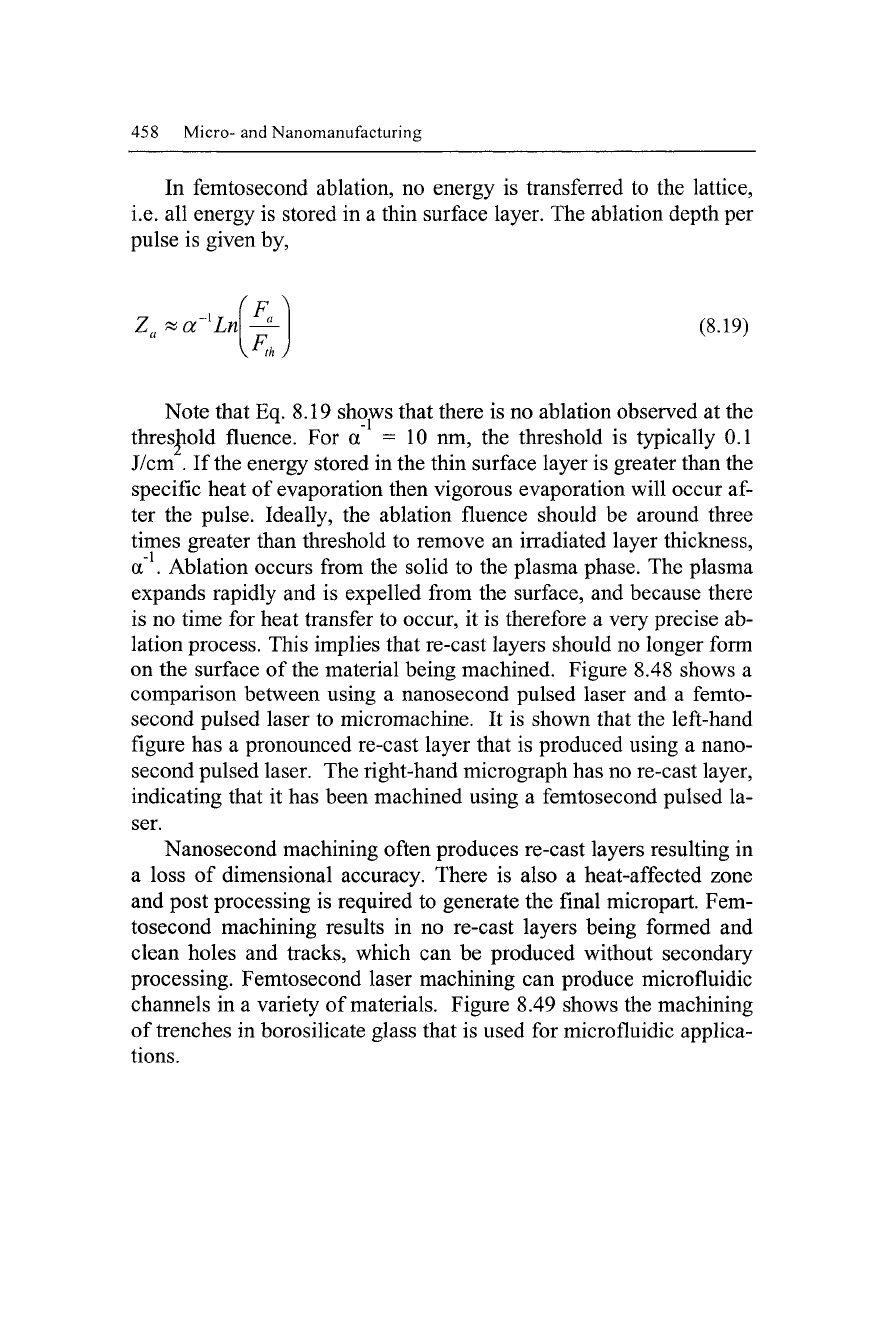
458 Micro-and Nanomanufacturing
In femtosecond ablation, no energy is transferred to the lattice,
i.e. all energy is stored in a thin surface layer. The ablation depth per
pulse is given by,
'a
^Ln\
^F^
\^
th
J
(8.19)
Note that Eq. 8.19 shows that there is no ablation observed at the
threshold fluence. For a =10 nm, the threshold is typically 0.1
J/cm . If the energy stored in the thin surface layer is greater than the
specific heat of evaporation then vigorous evaporation will occur af-
ter the pulse. Ideally, the ablation fluence should be around three
times greater than threshold to remove an irradiated layer thickness,
a" . Ablation occurs from the solid to the plasma phase. The plasma
expands rapidly and is expelled from the surface, and because there
is no time for heat transfer to occur, it is therefore a very precise ab-
lation process. This implies that re-cast layers should no longer form
on the surface of the material being machined. Figure 8.48 shows a
comparison between using a nanosecond pulsed laser and a femto-
second pulsed laser to micromachine. It is shown that the left-hand
figure has a pronounced re-cast layer that is produced using a nano-
second pulsed laser. The right-hand micrograph has no re-cast layer,
indicating that it has been machined using a femtosecond pulsed la-
ser.
Nanosecond machining often produces re-cast layers resulting in
a loss of dimensional accuracy. There is also a heat-affected zone
and post processing is required to generate the final micropart. Fem-
tosecond machining results in no re-cast layers being formed and
clean holes and tracks, which can be produced without secondary
processing. Femtosecond laser machining can produce microfluidic
channels in a variety of materials. Figure 8.49 shows the machining
of trenches in borosilicate glass that is used for microfluidic applica-
tions.
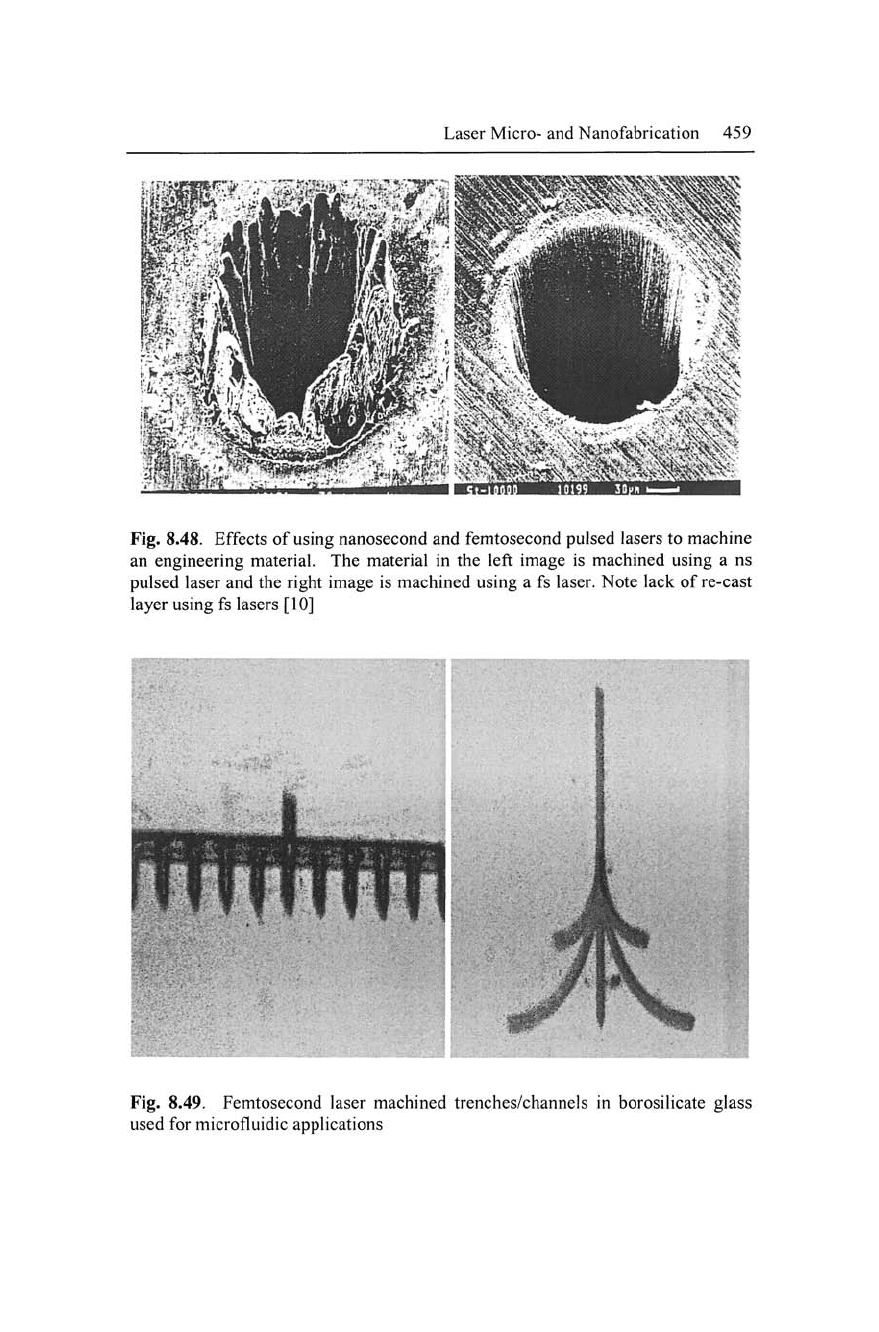
Laser Micro- and Nanofabrication 459
Fig. 8.48. Effects of using nanosecond and femtosecond pulsed lasers to machine
an engineering material. The material in the left image is machined using a ns
pulsed laser and the right image is machined using a fs laser. Note lack of re-cast
layer using fs lasers [10]
Fig. 8.49. Femtosecond laser machined trenches/channels in borosilicate glass
used for microfluidic applications
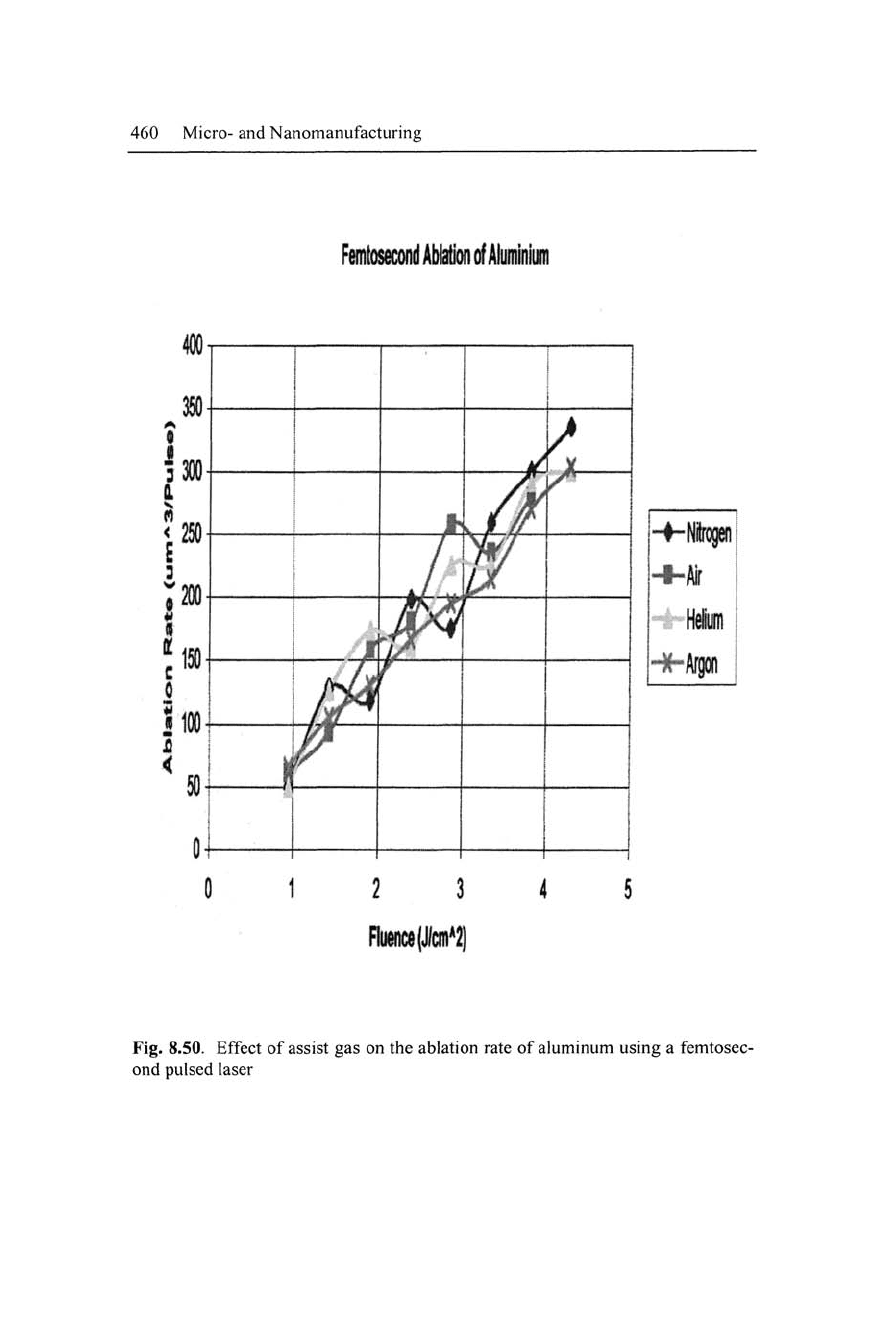
460 Micro- and Nanomanufacturing
2
3
RiieflC8(lcin*^
Fig. 8.50. Effect of assist gas on the ablation rate of aluminum using a femtosec-
ond pulsed laser
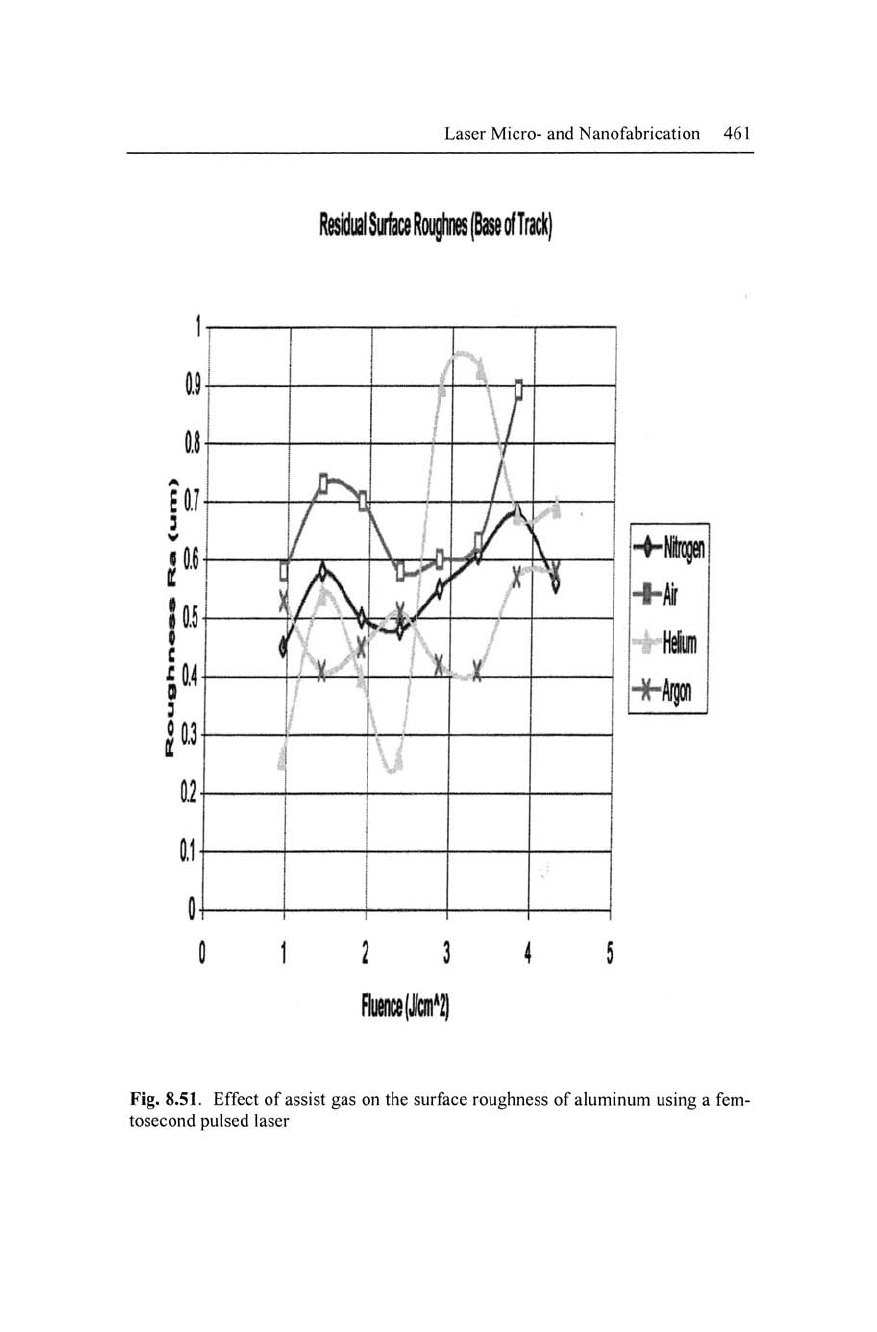
Laser Micro- and Nanofabrication 461
Fig. 8.51. Effect of assist gas on the surface roughness of aluminum using a fem-
tosecond pulsed laser
